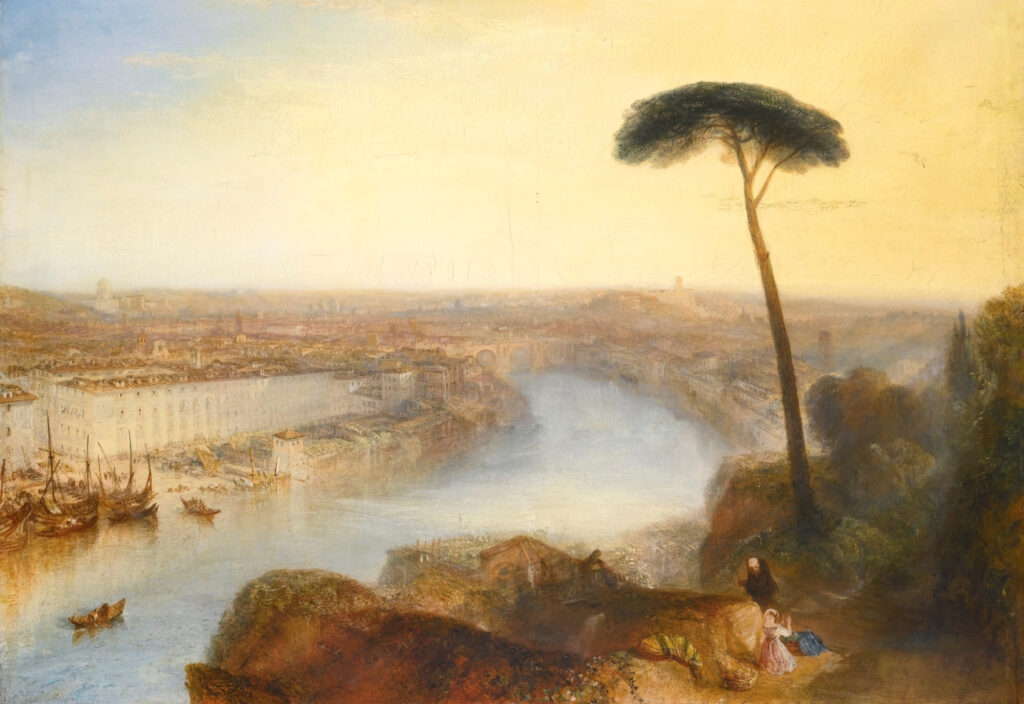J. M. W. Turner’s Rome, from Mount Aventine (1836) is widely regarded as one of the most significant and breathtaking views of the Eternal City ever committed to canvas. This masterpiece, a stunning synthesis of light, atmosphere, and classical grandeur, captures Rome in all its historical and aesthetic majesty. Exhibited at the Royal Academy in 1836 and later entering private collections, Rome, from Mount Aventine epitomizes Turner’s ability to render landscapes with an ethereal, almost supernatural glow. It is not just a cityscape but an evocation of Rome as the embodiment of history, civilization, and artistic triumph.
Turner and the Grand Tour Influence
Turner’s lifelong fascination with Italy, and particularly Rome, was deeply shaped by the tradition of the Grand Tour. By the late 18th and early 19th centuries, Italy had become an essential destination for European artists and intellectuals, a place where antiquity and the Renaissance could be studied firsthand. Rome, in particular, was considered the pinnacle of this experience. It was a city where the ruins of an ancient empire stood alongside the artistic achievements of Michelangelo, Raphael, and Bernini.
Turner first visited Rome in 1819, sketching prolifically and absorbing the light and landscape that would later dominate many of his works. He returned in 1828, deepening his engagement with the city’s architecture, atmosphere, and history. By the time he painted Rome, from Mount Aventine, Turner had thoroughly internalized the city’s grandeur and infused it with his own artistic vision.
The View from Mount Aventine: Symbolism and Perspective
The Aventine Hill, one of Rome’s famed seven hills, was a site of mythological and historical significance. It was traditionally associated with the plebeians of Rome, as opposed to the patrician-dominated Palatine Hill. By the 19th century, however, the Aventine had become a place of tranquility, home to monastic gardens and stunning panoramic views.
Turner’s vantage point allows him to encompass a vast sweep of the city, from the Tiber River winding through the composition to the dome of St. Peter’s Basilica dominating the skyline. The positioning of the Basilica is crucial—it serves as both the spiritual and compositional anchor of the piece. Turner’s Rome is not just a physical location but an idea, a testament to the endurance of civilization and the sublime beauty of human achievement.
Turner’s Light and Atmosphere: A Luminous Rome
One of Turner’s defining characteristics as a painter was his unparalleled mastery of light. In Rome, from Mount Aventine, he bathes the city in a golden radiance, capturing the shifting luminosity that he had observed in his travels. This effect recalls the sfumato of Leonardo da Vinci and the atmospheric perspective of Claude Lorrain, whom Turner deeply admired.
The painting is suffused with a hazy, dreamlike quality, a hallmark of Turner’s later style. This is not a sharply delineated cityscape but one that dissolves into light and air. The Tiber, which in reality is a murky and sluggish river, is transformed into a shimmering ribbon reflecting the sun’s glow. The buildings, rather than appearing as static structures, seem to dissolve into the atmosphere, reinforcing the idea that Rome is both eternal and ephemeral—a city of the past and the present, solid yet transient.
Classical and Romantic Themes
Turner was both a classicist and a romanticist, and Rome, from Mount Aventine reflects this duality. On the one hand, it pays homage to the classical traditions of landscape painting, particularly the works of Poussin and Lorrain. These artists had depicted Rome as an idealized vision of antiquity, and Turner follows in this tradition by presenting a Rome that is bathed in poetic grandeur.
Yet Turner also infuses the painting with a deeply romantic sensibility. This is not a cold, archaeological reconstruction of the city; rather, it is an emotional response to Rome’s legacy. The interplay of light and color, the almost dissolving forms, and the sweeping vista all contribute to a sense of awe and reverence. In this way, Rome, from Mount Aventine transcends mere topography—it becomes a meditation on time, memory, and the sublime.
The Painting’s Reception and Legacy
Upon its exhibition in 1836, Rome, from Mount Aventine was met with widespread acclaim. Critics and viewers alike marveled at Turner’s ability to capture the essence of Rome in such a transcendent manner. The painting was commissioned by Hugh Munro of Novar, a Scottish patron and an avid supporter of Turner’s work. Munro’s taste for Italian landscapes aligned perfectly with Turner’s own artistic vision, making him an ideal collector for such a masterpiece.
Turner’s reputation as a visionary landscape painter was solidified by works like Rome, from Mount Aventine, which demonstrated his ability to transform real-world locations into almost spiritual experiences. Later artists, including the Impressionists, would draw inspiration from Turner’s handling of light and atmosphere, while modern scholars continue to regard the painting as one of the finest depictions of Rome ever created.
Comparisons with Other Views of Rome
Turner was not the first nor the last artist to paint Rome from an elevated perspective, but his interpretation remains unparalleled. Earlier artists such as Gaspar van Wittel (Vanvitelli) and Giovanni Paolo Panini had produced detailed and meticulous views of the city, emphasizing architectural precision. In contrast, Turner’s Rome is one of mood, light, and emotion.
Even among Turner’s own works, Rome, from Mount Aventine stands out. While he painted numerous Italian scenes, including other views of Rome, this particular composition achieves a balance of grandeur and intimacy that few other paintings can match. It distills the essence of the city in a way that is both historically resonant and timelessly evocative.
The Eternal City Through Turner’s Eyes
Rome has always been a city of paradoxes—ancient yet ever-changing, monumental yet personal, chaotic yet harmonious. Turner’s Rome, from Mount Aventine captures these contradictions and synthesizes them into a vision of extraordinary beauty. The painting does not merely depict Rome; it reimagines it, elevating it to a realm of myth and memory.
For modern viewers, the painting continues to offer new insights. It speaks to the power of light, the passage of time, and the enduring legacy of human creativity. As one of the greatest landscapes ever painted, Rome, from Mount Aventine remains a testament to Turner’s genius and to the timeless allure of the Eternal City.
No comments yet.








